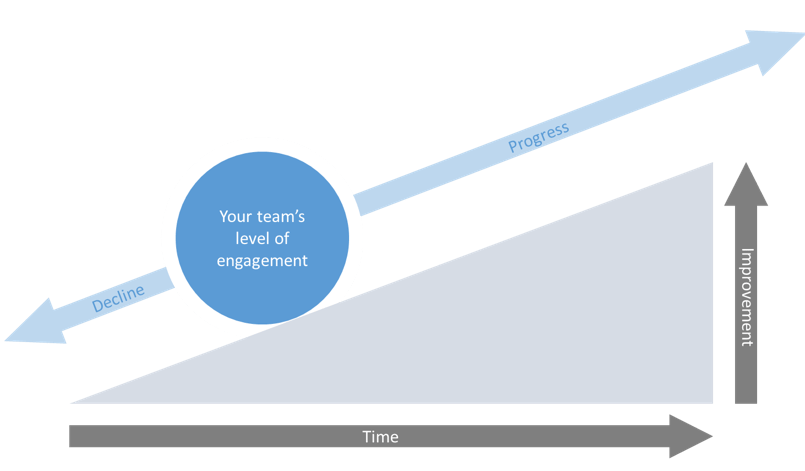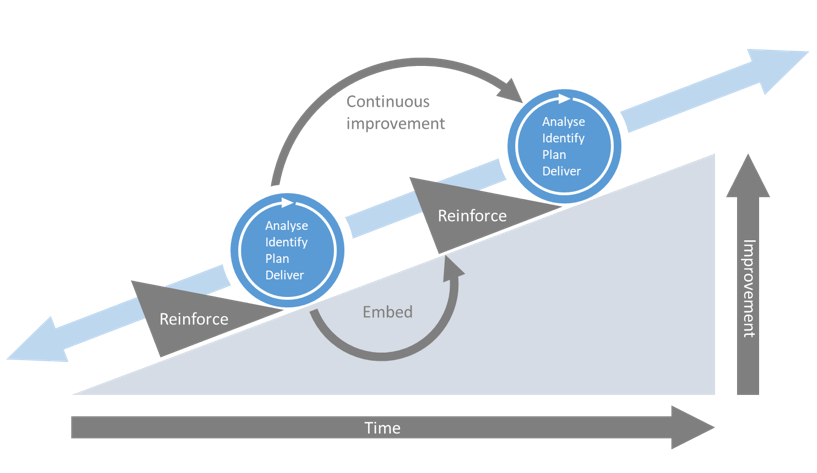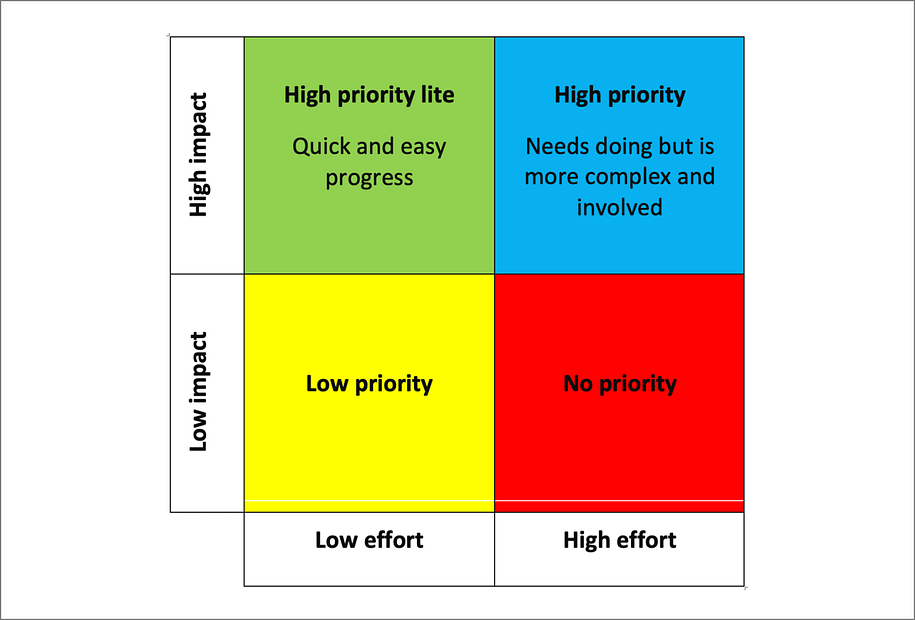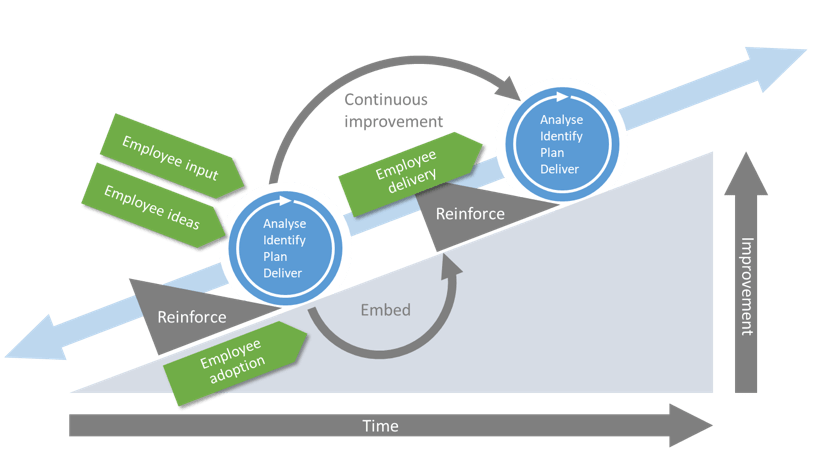
PART 6 - TAKING ACTION
Introduction: Make a sustainable, positive difference
Let’s recap. In Part 1, we looked at what employee engagement is, why it’s important and what it means for you. In Part 2, we looked more closely at your role and responsibilities. In Part 3, we considered strategic direction and approach, including your own engagement. In Part 4, we explored your employee engagement landscape, and in Part 5, we examined the drivers of engagement within your responsibility and control.
By now, you may have a growing sense of what you want to do, and why, and how you might get there.
So, it’s time to take action! But where do you start?
First, let’s be absolutely clear what we mean when we talk about ‘taking action’. By taking action, you’re aiming to make a sustainable, positive difference to engagement levels in your team. Beyond that, you may have specific performance outcomes in mind, but it all comes down to getting the very best out of your team, all the time, without pushing and pulling.
You should never stop striving to do this – it’s fundamental to your success as a people manager.
Important, permanent adjustments
When we talk about ‘taking action’, therefore, we’re talking about making some important, permanent adjustments to your approach and behaviour regarding team and people management, whilst encouraging your team to do the same. Not just on an annual basis. Nor quarterly. Depending on the volume and scale of improvement required, you may have to look at changing your approach from a monthly, weekly and possibly even daily point of view.
In other words, the greater the distance between where you are today and where you want to be tomorrow, the greater the frequency of dedicated action required.
We have identified two broad categories of activity:
- Continuous reinforcement and improvement of team engagement
- Championing and promoting the engagement agenda
We’ll explain and explore each of these below, but we want to emphasise up front that they are interdependent – you will not be able to succeed doing only one or the other, it must be both. The action you take to reinforce and improve engagement will make the difference. The action you take to champion and promote engagement will maintain the momentum.
Think of it this way:

Continuous reinforcement and improvement of engagement
Overnight transformations are rare. True progress is often incremental – it takes time and effort. It’s often experimental, requiring trial and error. And true progress needs you to understand that there is no finish line. If you’re not moving forwards, you’re sliding backwards – especially when it comes to employee engagement.

None of this is to say that improving employee engagement needs to be a laborious and exhausting disruption to the day job. Quite the opposite, in fact. At first, change may feel awkward and uncomfortable, as is typically the case. Getting it right means finding ways to incorporate it into your ways of working. In time, the changes you choose to make may become second nature.
But if you ignore it, it will not get any easier and it will not go away.
Continuous improvement
Adopting a ‘continuous improvement’ mindset will put you in a stronger, healthier position. By focusing your efforts on getting better all the time – as opposed to waiting until you have an issue – you become more comfortable, more capable and more adept at navigating risks and opportunities. It will also help you to consolidate and build on your successes whilst learning valuable lessons from anything else.
There are numerous approaches to continuous improvement out there, but we don’t need to get into that level of detail. We recommend that you simply follow this sequence in an ongoing cycle:
- analyse your current state;
- identify your opportunities for improvement;
- plan change;
- deliver change; and
- embed and reinforce progress.

Monitoring (and measuring) employee engagement
There is more to monitoring engagement than surveys, so for now, let’s avoid the S-word.
How engaged are your team? No, don’t look at your latest S-word results, if you have them. And no, don’t cast a furtive eye over your team either. Pause for a second, look out the window and think. Could you honestly say they’re highly engaged? Not particularly engaged? Somewhere in the middle, maybe? Or are things worse than you’d care to admit?
Chances are, you can estimate your team’s current state of engagement without needing to examine any hard data. Assuming you’re in regular and observant contact with your team, you’ll be surrounded by informal indicators from which you can intuitively extrapolate how things probably are and roughly determine whether things could be better and by how much. For example:
- When and how do people arrive at work? In good time and buoyant with positive attitude?
- How do they behave in conversations, meetings and other events? Are they punctual? Do they pay attention? Do they participate?
- Are general workplace comments and conversation more positive than negative?
- How healthy do relationships between team members appear to be? Can you detect any tensions?
- Are they generous or grudging with their discretionary effort?
Paying attention to your management senses
Contrary to popular opinion, you don’t have to measure something to the nth degree to be able to improve it. Having numbers to crunch can be helpful, but not if they distract you from what you already know or obstruct you from doing what you need to do.
Monitoring engagement closely, however, is essential. Think of it like driving a car: your team is the vehicle and you are the driver, working hard to keep them on course and heading in the right direction. You monitor the road, the dashboard, the rear-view mirror, adjacent lanes, and so on – nudging left or right, making minor adjustments little and often, occasionally changing gear or direction. Sometimes the changes may be obvious and sometimes they may be more subtle, introduced without signalling that change is afoot. All of this helps you to complete your journey as efficiently and pleasantly as possible.
Paying attention to what your management senses are telling you, and taking time to reflect on those inputs, is really all you need. And if you’re not in regular enough contact with your team, or not sure you can trust your management senses: congratulations – you may have just identified your first improvement actions.
In an ideal world, the relationship between you and your team members would be such that mature, open and informal conversations could be had at any time regarding how they are feeling about work, why they feel that way, and how things could potentially be improved. If something is not right, they are able to manage the situation themselves or approach you directly with appropriate feedback or requests for support. Or you can approach them if you feel there may be something you need to be aware of or intervene in. You will listen, advise and take appropriate action to help mitigate the risks or resolve the issues before they can have too much of an impact or escalate out of all proportion. In this way, misunderstandings are few, negative feelings are filtered out quickly, nasty surprises are kept to a minimum and everybody feels valued and respected. When challenges do arise, the team are more likely to work with you to understand and overcome them.
Exploring engagement through data and feedback
This ideal state is rare, though. In its absence, if you want or need to be a little more scientific, then by all means take a look at the numbers. Levels of absence and attrition, for example. Employee relations cases. Quality of job applicants. Participation in workplace initiatives, such as development opportunities. Formal feedback from customers and colleagues. And so on. These are all good indicators of whether a team is engaged and whether the work environment is engaging. Individually, these sources of data may hint at what you need to know. Together, they may tell a more compelling story that can help to test and calibrate your gut feel.
Many large employers engage third-party survey providers with sophisticated, scalable solutions built around proprietary definitions and complex analytical methodologies, capable of delivering bespoke surveys to tens of thousands of employees around the world, analysing vast quantities of data in a relatively short space of time and generating user-friendly reports to facilitate strategy and action. Smaller businesses may consider more modest third-party solutions or even create their own engagement surveys using one of many available online tools.
For the engaging manager, engagement surveys are a helpful tool that can provide valuable clues and insights when implemented with care and perspective. But they are not a perfect solution and they are certainly not the only solution. Instead, they should be seen as one of several sources of supplementary data that can help to fine-tune your thinking.
Besides survey-based solutions, many employers use focus groups, stay and exit interviews, social media monitoring and additional ‘anonymous’ feedback channels. Each of these enable you to explore employee experience and perceptions in different ways, from different angles, helping to create a more three-dimensional picture of engagement and its causes and consequences. A combination of different tools will open the door to analysis that is more robust and action planning that is more precise.
Which brings us back to why we’re doing all of this in the first place. Measuring engagement is not the goal, any more than ‘measuring your weight’ is the goal. The goal is improvement. Measurement is nothing more than an enabling tool and the data is nowhere near as important as what we do with it.
When all is said and done, the purpose of monitoring and measuring engagement is to help you understand what you need to keep doing, what you need to stop doing and what you need to start doing.
Recognizing your strengths and identifying your opportunities for improvement
Once you’ve collated all your inputs, you’ll need to analyse it all in order to identify your areas of risk and opportunity. We recommend adopting a simple framework representing the local drivers of engagement and aspects of your engagement landscape that you consider most relevant. Review your inputs against your framework and capture whatever thoughts emerge.
To begin with, review the inputs privately. What do they tell you? They may already point to specific changes that need to be made, risks that need to be addressed or issues that need to be resolved. Or they may simply indicate areas in need of improvement. Two kinds of potential action are likely to emerge: those that are sensitive and those that can be shared. Is there anything obvious that you, in your capacity as manager, just need to do? Self-development, for example, or dealing with a complex situation between two members of your team. If so, separate it from the rest and approach it accordingly.
At this point, take a few steps back and remind yourself: this is about developing your team into the most high-performing engine of productivity it can possibly be. It’s not personal, but it may be challenging. You may have to confront some hard truths, make some tough decisions or carefully consider some disruptive points of view.
Now, look again with fresh eyes
To accelerate you into action, there’s no need to be overly scientific about this. For each area in your framework, challenge yourself to decide whether things are:
- great;
- good enough;
- could be better; or
- could be a lot better.
Regarding those items which are ‘great’ or ‘good enough’, there may be some things you’re already doing well as a manager and a team, but recognising your strengths isn’t just about ticking boxes and moving on. Why are they working well? What can you learn from them and how can you apply that strength elsewhere to make improvements? At the same time, just because something is working well now doesn’t necessarily mean you can leave it unattended. Areas of strength might deteriorate if you turn your attention away to focus elsewhere. You need to do more than simply recognise strengths, you need to reinforce them (to keep them strong) and repurpose them (into areas that need strengthening).
Over-reliance on one strength is also a risk. Although doing lots more of the same appears to demonstrate action and commitment, it may not address any gaps and therefore may not actually equate to improvement.
Once you have reviewed your level of capability in each area, you’ll have a good sense of which areas need reinforcement and which need improvement. Don’t keep going back to your inputs, they’ve served their purpose. It’s time to move on before ‘analysis paralysis’ begins to drain your momentum.
Building your plan and bringing it to life
You now need to work out what you (and your team) are actually going to do in order to reinforce and improve. A plan of action. Don’t generate this in isolation – involve your team, either as a group or as individuals. Talk them through the inputs and lead them through a further round of analysis to test and build on your thinking. You’ll need to facilitate the dialogue from ‘we need to do something in this space’ to ‘we need to do something that addresses this particular requirement’ to ‘we need to do this specific thing or set of things’.
For example:
- Arrange a programme of developmental activity for the team, designed to help them better understand their strengths or motivations, or that equips them with knowledge and tools to build resilience.
- Arrange a series of briefings and workshops between your team and other departments with whom they interact frequently (either in collaboration or the provision or receipt of service) in order to improve relationships and ways of working.
- Engage senior management in providing regular briefings to your team about relevant events, strategies and decisions across the wider organisation.
- Design and implement a ‘triage system’ for incoming work to strengthen how the team receives, communicates, distributes and delivers new and changing stakeholder demands.
- Review the team onboarding and induction processes, looking for and acting on opportunities to create a faster, smoother and more positive experience for all joiners – helping to equip them with the knowledge, tools and relationships to feel fully engaged and capable in their new role as quickly as possible.
- Review team mechanics with a view to making them as inclusive as possible, or fully supportive of the flexible working needs of your team members.
- Take a good hard look in the mirror through the eyes of others, using such tools and techniques as 360° feedback, the Johari window and psychometric assessment to identify and understand ways in which you can improve your management behaviour and relationships with others.
Get as detailed as you can about what you’re going to do. Challenge yourselves to be as precise as possible and as confident of success as you can be. How will the action bring about the desired results? What are the desired results – how will you all know that you have been successful? What will the improvement look and feel like to everyone who benefits? Is it guaranteed to work, or is it an experiment? How long is it likely to take? Who will need to do what to make it happen? Who will be responsible for leading the activity?
Try to avoid tying your objectives to numerical targets, they can drive the wrong behaviours and cause everyone to lose sight of the true intention.
Don’t set any output limits for brainstorming and developing potential actions – who knows what great ideas you might miss if you stop the discussion before it’s run its course. Don’t set any input limits, either. Conduct research and consult with others. Look outside your team and look outside your organisation.
Making decisions
Once you believe you’ve identified all your options, it’s time to trim down to a manageable list of priorities.
If you’ve allowed your team to spread their creative problem-solving wings during the research, analysis and brainstorming, you’ll probably have quite a mixed bag of ideas to consider. Some may be unrealistic. Others may be too ambitious. Some may not be ambitious enough. Every contribution, however, should be taken seriously and treated fairly and with respect.
Don’t shy away from any feedback, no matter how you feel about it. Bear in mind that trying to make things better and not succeeding can still have a positive effect on team engagement. As can discussion about how to approach and address challenges that appear impossible at first glance. Even exercises focused on hypothetical objectives (‘We can’t change that, but if we could, what would we do?’) can have a positive effect.
Allow those conversations to happen and take part in them. Give your team the freedom to explore their ideas and draw their own conclusions. Let them be part of the decision-making process, help them to understand the decisions made and allow them to query and challenge.
Key to fair and effective prioritisation is the arrangement of all options into an order defined by how much effort each is likely to take versus how much impact each is likely to have. We recommend using the following chart to plot effort versus impact for each potential action on your shortlist:

Click to enlarge diagram
Your immediate plan of action should focus on the ‘high priority’ items, balancing the quick wins with more complex undertakings. Try not to let any appetite for quick wins influence the outcomes of this process – some of the most important improvements may be complex undertakings that require gradual, incremental change.
Making it happen
Now you and your team have a solid foundation for your action plan, or rather: your programme of improvement projects. Allow a moment of congratulation, but this is where the real work begins.
Believe it or not, this series of projects is the most important work you’ll do, because it will, if successful, help to improve everything else. Remember, you are working to enhance team efficiency, productivity and performance. A happier team is an important part of that, but a high-performing team is your ultimate ambition.
So, treat it properly and professionally, like any other priority project. If it helps, think of this as your ‘enhanced team performance programme’ rather than your ‘improved team engagement programme’.
Give it due time, attention and resources – give it a life of its own. To succeed, all these actions need to be owned, sponsored, championed, led, monitored, supported, celebrated and embedded. This is not something you stop and start depending on when you are under scrutiny. This is something you’re doing for yourself, not for anyone else, because you understand and agree with the value of doing it. If you’re only doing it because someone else has told you to, it will never work.
At appropriate intervals, by yourself and with your team, review and update the programme, gathering fresh inputs when appropriate. Are you still heading in the right direction? Is everything you agreed and decided still valid? What progress has been made and what has changed? Is there opportunity to revisit potential actions that didn’t make the shortlist last time? Have some areas in your framework shifted from ‘improve’ to ‘reinforce’? Have others gone the other way?
When you do this is up to you. It might be helpful to align with other schedules, such as your organisation’s survey schedule, if it has one, but don’t let outside influences dictate too much – do what’s right for your plan and your team.
Speaking of which…
Championing and promoting the engagement agenda
This is not a journey you can make alone. Granted, some of the steps that need to be taken may be yours and yours alone, but if you don’t make special effort to bring your team with you to the land of higher engagement, they may never arrive.
It’s easy to assume that they’ll all be on board automatically – it’s all for their own good, after all… Human nature and common sense are rare bedfellows, though. Unfortunately, whilst you can lead a disgruntled employee to a better workplace, you cannot simply make them engaged.
You will need to work at engaging them in becoming more engaged. You can’t do it all for them, any more than anyone else can do it all for you, and you cannot make them do it the best of their (discretionary) ability. They have to want to become a more engaged team and, importantly, they have to want to become your more engaged team.
Another way to look at it is as follows – the entire improvement process welcomed, supported and enhanced by a team who are ready and willing to contribute the discretionary thought and effort you need to make your ambitions a reality:

Engaging your team in becoming more engaged
To be successful, you need your team to understand and believe in what’s happening, why it’s happening and what they need to be doing in order to help make it happen. You also need to convince them that their engagement is your number one priority. Hopefully that will be the case anyway, but you need to be proving it every minute of every day.
In some respects, it’s not that difficult. Everything you do needs to demonstrate your personal commitment to your team and to making things better for them. The moment you demonstrate anything else, you’ll lose ground more quickly than you gained it.
Make it a visible priority – something you grant VIP access to your time and attention, rather than always sending it to the back of the queue. Help them understand why it’s your priority. At the same time, if relevant, help them to understand why it’s important to your organisation. Bring it all to life in a way that is real and meaningful for them. Keep it fresh and alive and always on the radar – important today, tomorrow, always. Help it to become a regular and natural feature in team conversations. Play back what they tell you, so they know they’ve been heard. Encourage the anticipation and celebration of progress.
For example:
- Know your audience. Talk to your team in terms that will make sense to them and resonate with them. Carefully select the right vocabulary. Don’t just regurgitate everything you encounter or receive, translate this into their language/team chat. Dial certain messages up or down depending on their relevance to your people. Embed the language of employee engagement into your team, and make sure it’s the right language, including your tone and body language.
- Magic moments. A ‘safety moment’ is a brief discussion about a safety-related topic at the beginning of a meeting, shift or event. Driving these into the routine until they become a comfortable habit can help to reinforce awareness, familiarity and commitment, and contribute to building a positive safety culture. Why not do the same for engagement?
- Name your goal. Giving desired outcomes an identity, like ‘Zero Harm’ and ‘Think Privacy’, or the names of many social movements, can go a long way to providing people with an easily recognisable, understandable cause they can grasp, rally to and unite behind, whilst making ongoing communication far simpler and more effective.
- Roll up your sleeves. Put simply, don’t leave the dirty work to everyone else – and that includes always doing your homework and showing up to every meeting.
- Nice surprises. As anyone who has ever received an unexpected card, gift or flowers knows, doing something nice for someone, simply because you were thinking of them, can be extremely powerful. Unprompted, meaningful contributions that demonstrate your constant, proactive and wholehearted commitment to the team engagement agenda can have a massively positive impact.
- Tell the world. There’s no commitment like a public commitment. If it’s important, and you mean it, broadcast it beyond your team. Let them know how much they mean to you by telling everyone else. Put your plans up in plain sight for all to see and be proud of. Even better, get out there with your team and spread the word, to encourage and enable others to follow in your footsteps.
Don’t let it fade, lose meaning and become a chore.
Role model what you expect from them and manage their expectations carefully, every step of the way. Openly and warmly fulfil your responsibilities and involve them as much as you can. Be upbeat and eager. Be honest, transparent and forthcoming. Be consistent and persistent. Be receptive, responsive, participative and appreciative. Be firm but fair. Be optimistic and ambitious but patient and open to challenge.
Throughout, our message to you has been that employee engagement matters and that it makes a difference. Your job now is to share that message with your team. They need to know and believe it too.

